In a groundbreaking development that could reshape our understanding of the Red Planet, researchers have uncovered compelling evidence of liquid water deep beneath Mars’ surface. Using seismic data collected by NASA’s InSight lander, scientists have proposed that Mars harbors vast reservoirs of water located between approximately 7.1 and 12.4 miles (11.5 and 20 kilometers) underground. This revelation not only challenges long-held assumptions about Mars’ arid present but also hints at a complex geological history that may have implications for future exploration and the search for extraterrestrial life.
Unveiling the Deep Secrets of Mars
For decades, scientists have speculated about the presence of water on Mars, primarily based on evidence that the planet once had abundant surface water billions of years ago. Numerous studies have documented signs of ancient riverbeds, lake deposits, and mineral formations that indicate a watery past. However, the idea that liquid water could persist in the Martian subsurface today is relatively new and has been met with both excitement and skepticism within the scientific community.
Recent analysis of seismic data from the InSight mission has provided a fresh perspective. Researchers from Hiroshima University and the Research Institute for Marine Geodynamics in Japan, led by Ikuo Katayama and Yuya Akamatsu, have meticulously examined the seismic waves generated by marsquakes. Their study suggests that the velocities of these waves change in a manner consistent with the presence of liquid water in the deep subsurface.
The InSight Lander and Its Seismic Pioneering
Launched in 2018, NASA’s InSight lander marked a milestone as the first mission dedicated to studying the interior of Mars. Equipped with the Seismic Experiment for the Interior Structure (SEIS), the lander has been busy recording the faint tremors of marsquakes—vibrations that travel through the Martian crust. Unlike Earth’s seismic events, which are closely monitored to predict and understand earthquakes, marsquakes provide scientists with a unique opportunity to peer beneath the surface of another planet.
The SEIS instrument is capable of detecting three types of seismic waves:
- P-Waves (Primary Waves): These are compressional waves that travel in a back-and-forth motion, similar to sound waves propagating through air.
- S-Waves (Secondary Waves): These shear waves move perpendicular to the direction of travel, offering insights into the materials they pass through.
- Surface Waves: As the name suggests, these waves travel along the planet’s surface, akin to ripples generated in a pond.
By analyzing the speed and behavior of these seismic waves, scientists can infer the composition and physical state of the materials they traverse. In this case, variations in the wave velocities suggested that a significant layer between 11.5 and 20 kilometers below the surface may be saturated with liquid water.
Interpreting the Seismic Signatures
Understanding how seismic waves interact with different materials is key to deciphering what lies beneath a planet’s surface. On Mars, the seismic signals captured by InSight indicate an anomaly—a region where the speed of the waves deviates from what would be expected if the subsurface were composed solely of rock and ice. Instead, the data is consistent with the presence of liquid water, which alters the propagation of seismic energy.
The researchers propose that this deep water reservoir could be maintained in a liquid state by a combination of residual internal heat and the presence of dissolved salts. On Earth, similar conditions allow for the existence of brine pockets in permafrost or deep within the crust. In the case of Mars, these salty solutions could depress the freezing point of water, enabling it to remain liquid despite the planet’s frigid surface temperatures.
Implications for Mars’ Geological History and Habitability
The discovery of deep liquid water on Mars has profound implications for our understanding of the planet’s geological evolution. It suggests that Mars might still be geologically active in ways previously unrecognized. If liquid water exists today beneath the surface, it could play a critical role in ongoing geological processes such as mineral alteration, tectonic activity, and even the recycling of materials through the crust.
Moreover, liquid water is a fundamental ingredient for life as we know it. The possibility that Mars harbors subsurface water raises tantalizing questions about the potential for microbial life to exist in these hidden reservoirs. While the surface of Mars is bombarded by harsh radiation and extreme temperatures, the underground environment could offer a more stable habitat where life might persist, shielded from the hostile conditions above.
A Step Forward in the Search for Extraterrestrial Life
The search for life beyond Earth has long centered on the presence of liquid water. Mars has always been a prime candidate in this quest, given its history of water-rich environments. The latest findings from seismic analysis add a new layer to this narrative by indicating that water may not be a relic of the past but an active, ongoing component of Mars’ geology.

Future missions to Mars could focus on drilling or using advanced remote sensing techniques to explore these deep reservoirs. Such investigations would be challenging due to the extreme depths and the technical difficulties of penetrating the Martian crust, but they represent an exciting frontier in planetary science. Successfully accessing these water deposits could provide unprecedented insights into Mars’ potential to harbor life and inform strategies for human exploration and habitation.
The Role of International Collaboration in Mars Exploration
The current study underscores the importance of international cooperation in space research. Scientists from Japan’s Hiroshima University and the Research Institute for Marine Geodynamics have collaborated closely with data provided by NASA’s InSight mission. This synergy between space agencies and academic institutions worldwide exemplifies how global partnerships can accelerate scientific discovery and enhance our understanding of complex planetary systems.
As more missions are planned to explore Mars, including potential sample return missions and future landers equipped with advanced drilling technologies, the international community is poised to play a critical role in unraveling the mysteries of the Red Planet. Collaborative efforts will be essential not only for technological advancements but also for interpreting the wealth of data that future missions are expected to generate.
Challenges and Future Directions
Despite the promising evidence, the notion of deep liquid water on Mars remains subject to rigorous scientific scrutiny. Seismic data, while powerful, can be open to interpretation, and alternative explanations for the observed wave velocities must be considered. Critics of the current model argue that additional data, possibly from future seismic missions or complementary geophysical instruments, will be necessary to conclusively prove the presence of liquid water.
Future missions might incorporate a broader suite of instruments capable of measuring not just seismic activity but also magnetic fields, gravitational anomalies, and thermal signatures. These additional datasets could help refine our models of the Martian interior and provide a more comprehensive picture of the planet’s subsurface environment.
Moreover, understanding the chemical composition of the potential water reservoirs is a critical next step. Determining whether these waters are fresh or briny—and what minerals or organic compounds they might contain—could offer further clues about the potential habitability of Mars. Such information would be invaluable for astrobiologists and planetary geologists alike.
The Broader Context of Mars Exploration
This new discovery comes at a time when interest in Mars is resurging, driven by both scientific curiosity and the prospects of human exploration. The idea that Mars may still harbor liquid water underground not only fuels the imagination but also has practical implications for future manned missions. Water is a vital resource for sustaining life, and the ability to access it in situ could dramatically reduce the logistical challenges associated with long-term habitation on Mars.
In the broader context of planetary exploration, these findings contribute to our evolving understanding of how planets develop, evolve, and potentially support life. Mars, with its rich history of water and its complex geological processes, continues to serve as a natural laboratory for studying the dynamics of terrestrial planets. Insights gained from Mars can inform our understanding of other celestial bodies, including exoplanets in distant solar systems that may also harbor water and, by extension, life.
Conclusion: A New Chapter in Mars Research
The new analysis of seismic data from the InSight lander represents a significant milestone in our quest to understand Mars. The evidence suggesting the presence of liquid water deep underground not only challenges previous assumptions about the planet’s present-day environment but also opens up exciting possibilities for future exploration. If confirmed, these findings could pave the way for new missions designed to probe Mars’ hidden water reservoirs, offering a fresh perspective on the potential for life on our neighboring planet.
While many questions remain unanswered, the discovery stands as a testament to the power of modern scientific techniques and international collaboration. As researchers continue to sift through data and refine their models, the enigmatic depths of Mars may soon reveal secrets that have been hidden for eons. In the process, humanity inches closer to unraveling the mysteries of one of the most captivating worlds in our solar system—a world that, beneath its dusty exterior, may still hold the key to understanding the origins of life itself.










